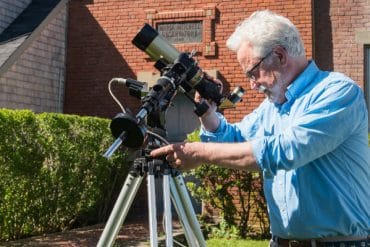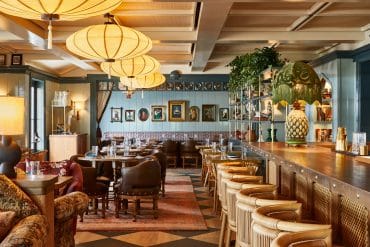
THE AZORES
If you sail directly east from Nantucket, the first landfall before you hit Europe is the Azores—an archipelago of nine volcanic islands roughly one thousand miles off the coast of Portugal and as pretty as…well, Nantucket. Not surprisingly, the links between the two places run old and deep, back to the glory days of the whaling industry, when ships set out from ‘Sconset and next dropped anchor on Sao Miguel or one of its sister islands.
Some Nantucket families today can still trace their ancestry back to the Azores, and although they were a major nautical crossroads for centuries, by the late 1800s, they’d fallen so far off the map
that Mark Twain, in The Inno- cents Abroad, wrote: “Out of our whole ship’s company there was not a solitary individual who knew anything whatever about them.”
And therein lies their charm. Relatively untouched and undiscovered, the Azores remain unspoiled by the hordes who flock to more popular vacation spots. While there are eight other islands to explore, Sao Miguel (an easy four-hour flight from Boston on SATA) boasts more than enough diversions to sustain the most jaded traveler’s interest.
The principal city, Ponta Delgada, is a throwback to when Portugal ruled the Seven Seas and provides the perfect place from which to explore the calderas, black lava beaches, dramatic rock formations, bu- colic countryside and fascinating towns that make it one of the most picturesque spots on earth. Think Hawaii meets the Scottish Highlands.
No place captures the romance of Sao Miguel better than Sete Cuidad (Seven Cities). Cresting the lip of a crater, you’re confronted by a fairytale view of twin lakes—one sapphire blue, the other emerald green—next to a village that looks like something from a child’s train set. Legend holds that a princess fell in love with a shepherd boy but was forbidden to marry him. They met one last time to say goodbye. One was blue-eyed, the other green, and their tears formed the distinctly colored lakes.
Scientists have a far less fanciful explanation, but the island’s improbable landscapes encourage fantasy. For instance, in Furnas—named for the volcanic fissures that give the place a whiff of sulfur and a micro-climate that allows for a breath-taking botanical garden—you can bathe in a thermal pool before feasting on a meal cooked in the ground by Mother Nature herself. Buried before noon and then ceremoniously dug up at dinner-time, the cozzido, or pot, containing slow-cooked sausage, chicken, beef, pork and vegetables is served with a delicious red wine from the mainland. Speaking of food, the seafood on Sao Miguel is reason enough to visit. Even their canned tuna is worth bringing an extra suitcase
to carry some home.
After mornings exhausting yourself by hiking, biking, surfing, or kayak- ing, you can spend the afternoon visiting a centuries-old tea plantation or see the handiwork of a nineteenth century nun who sculpted every major scene from the Old Testament…out of marzipan. As quaint as Nantucket, Sao Miguel even gives the Grey Lady a run for her money when it comes to hydrangeas, which grow wild and in profusion. To Nantucketers, that may sound like blasphemy. But it’s the truth. Go see for yourself.
 ICELAND
ICELAND
What’s not to love about a country where people shoot off fireworks at 10 a.m. because the sun barely peaks over the horizon during the winter months? Iceland, despite its forbidding name, is a magically picturesque winter destination that’s frequently warmer than Boston or New York, is easily accessible from the East Coast (direct flights on Iceland Air are roughly five and a half hours) and is chockablock with jaw-dropping natural wonders.
One of the first things visitors notice is how clean the air is, because the volcanic island relies primarily on geothermal power. Of course, the flip side is that when a volcano goes off, airports across Europe close. Iceland is one of the most recently and sparsely populated landmasses on earth, and its geology provides some of its most interesting attractions, including numerous geysers (the English word is derived from the Icelandic geysir), Gulfoss, the tallest waterfall in Europe, and a hauntingly beautiful lunar landscape of glaciers and tundra.
Soaking in thermal hot springs is a major outdoor activity, and one of the most popular, if commercial, options is the Blue Lagoon—an otherworldly spa that includes a milky blue lake with great plumes of steam rising off it that happens to be the by-product of a nearby geothermal power plant. Surrounded by lava fields, its waters are said to have healing properties, and in the dead of winter, its soothing warmth makes it the world’s most surreally beautiful hot tub. Combined with an in-water massage or other treatment, it’s like visiting a spa on another planet.
Whether you’re an equestrian or not, you might want to try riding an Icelandic horse, a diminutive breed descended from horses brought over by the Vikings that has since evolved in isolation. As a result, and unlike most other horses, the Icelandic variety are five-gaited, a unique pattern of walking that makes them especially fun to ride. Don’t be fooled by their resemblance to Shetland ponies, though—they’re as fast and spirited as most hot bloods.
 JACKSON HOLE
JACKSON HOLE
They call Jackson Hole “The Last of the Wild West,” a rugged American outpost where you can still find cowboys saunter- ing into saloons and wild buffalo and elk running through the valley. But this mountain town in Wyoming has come a long way from gun slinging and honky-tonk. Just this year, it was named the number one ski destination in the country, leading many long-time Jackson Hole ski bums and bunnies to sigh, “Ugh, the secret is out.” So for those islanders looking to drive their wagons west this winter, forget Aspen or Vale. Get out to Jackson.
Just flying in from Boston (via Salt Lake City) is worth the price of admission, as the plane lowers its landing gear in the shad- ow of the Tetons, one of North America’s youngest mountain ranges that juts up over seven thousand feet from the valley floor. The Tetons look ferocious, stacked like mounds of broken granite with some peaks too steep to hold snow. Immediately you can see why Jackson Hole Mountain Resort boasts some
of the most technical skiing in the Lower 48.
But you don’t need to be Bode Miller or Lindsay Vonn to enjoy this winter wonderland. Families can start the day by taking an enchanting horse-drawn sleigh ride through the Elk Refuge in town, and then head across the street to check out the National Wildlife Museum. Or better yet, take a snowmobile excursion through Teton National Park and bathe in the restorative waters of the Huckleberry Hot Springs. And for those looking for some real posh pampering, end the day at Snow King Resort in town, which recently underwent a complete renovation. There you can stay in a lavish condo and enjoy all the chic amenities on par with the White Elephant.
Dining in Jackson Hole offers an adventure all its own. To get a full sense of the local flavor, head to The Gun Barrel for their legendary mixed grill: elk, buffalo, and wild boar. More chichi Nantucket-style dining can be found at upscale restaurants like Trio and Local, but if you’re going to be in Jackson Hole, there is one place that all visitors must spend an evening: The Million Dollar Cowboy Bar, where you literally sidle up to a bar of old- growth wood on a saddle and listen to a live bluegrass. Sure, it may be touristy, but you’re a city slicker, so buck up.
In the end, winter in Jackson Hole is indeed about skiing and snowboarding. With a one-hundred-person tram taking you to the top of Jackson Hole Mountain Resort, you can make turns down as many vertical feet as your legs can handle. But beware: this isn’t your Sunday River-style skiing. Black diamonds here are for experts only, and there’s a good reason why they call Jackson Hole the Last of the Wild West.
 VIEQUES
VIEQUES
Vieques has long been a perfect target for Americans—quite literally. Dur- ing World War II, the island was a favorite bombing practice site for the US Navy, but has since been reclaimed as a below-the-radar vacation destination.
Situated six miles and a ten-minute Cape Air flight off the coast of Puerto Rico, Vieques is a delightfully laid back island, featuring pristine, remote beaches and crystal clear water. Just twenty-one miles long, Vieques is a tiny retreat that offers surprisingly inventive restaurants, a luxury W Hotel, and plenty of natural environment for the eco-tourist.
Beyond life on the beach, Vieques possesses an extraordinary natural phenomenon that is almost worth a trip in and of itself: Mosquito Bay, the brightest bioluminescent bay on the planet according to the Guinness Book of World Records. On the southern shore of the island, the bay has the highest concentrations of bioluminescent plankton on the planet, which creates a breathtaking effect when objects move in the water at night. Taking the bioluminescent bay tour, one is awestruck by the sight of fish darting from one side of the bay to another, appearing like florescent torpedoes. Diving off the pontoon tour boat takes the experience a step further as you see yourself glow in the dark.
Legend has it that the crew of a pirate ship, after sinking an unsuspecting vessel, became hysterical when the victims of its plundering appeared ghostlike in the water as they struggled for survival. The pirates found religion very quickly, believing that heavenly figures were about to come and haunt them for their misdeeds. For the experienced traveler, there are few encounters with nature that are indescribable, but this may be one of them.
For those seeking even more seclusion than the island of Vieques, boats can be chartered to neighboring Culebra, an even smaller island next to Vieques. Culebra could be described as the Tuckernuck of Vieques, a small and largely undeveloped island ideal for snorkeling and exploring. The warm water beaches on the island of Culebra include Flamenco beach, which is rated number two of the top most exotic beaches in the world for its crystal clear visibility underwater, colorful fish, and wildlife.
The accommodations on Vieques vary significantly from home rentals, to mid market hotels, to the luxury W Retreat & Spa. Other top rated lodging includes Blue Horizon, an oceanfront boutique resort with just ten rooms, giving guests a private hotel feel and peaceful escape.Bravo Beach Hotel is located fifteen minutes from the bioluminescent bay, and is only a short walk to town where you can enjoy a variety of shops, restaurants and island activities. Great Escape, an immaculately kept bed and break- fast surrounded by tropical plants and flowers, offers private balconies with ocean or mountain views.
While not identical to Nantucket, Vieques pro- vides an unusual opportunity to experience a natural phenomenon unique in the world, and its charm will appeal to those in love with Nantucket for the island’s size, tight-knit commu- nity, appreciation of nature, and yes, access by Cape Air.





